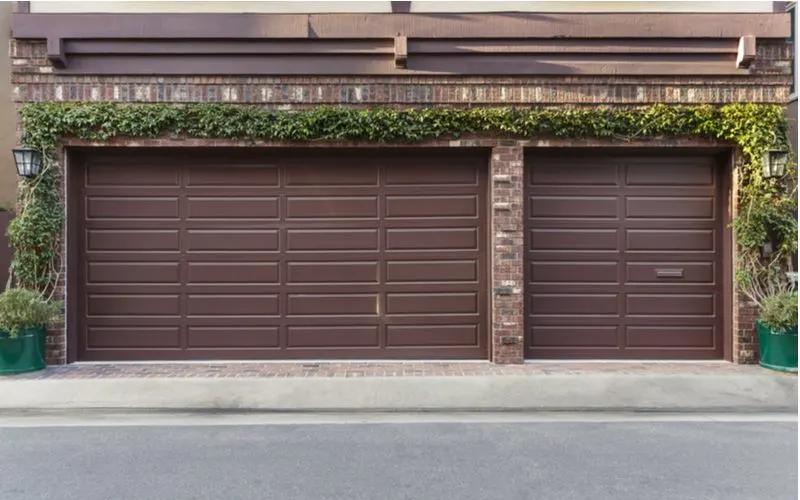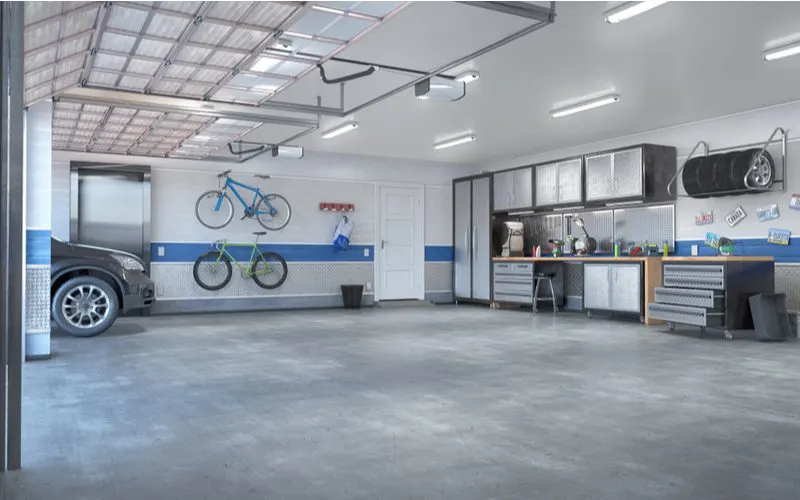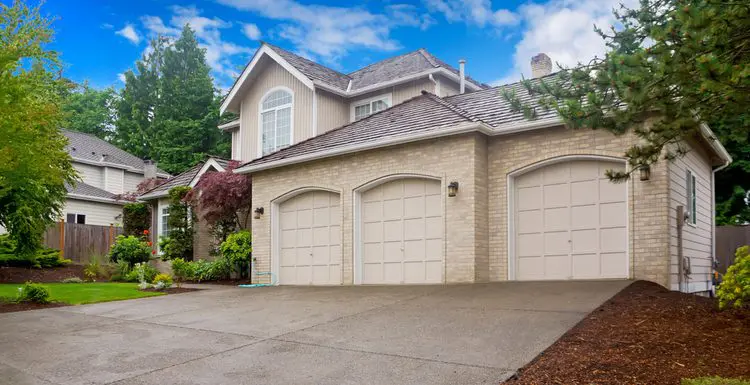When building something, it’s best to “measure twice, cut once.” That’s why it’s critical to know the average 3-car garage dimensions.
After all, you want to make sure your garage is big enough, right?
Read on to learn more.
Standard 3-Car Garage Dimensions
The average three-car garage features dimensions of about 32 feet wide by 22 feet deep.
Since those figures are averages, we know some garages will be bigger or smaller, but with car widths being what they are, there are certain minimums we can’t work around.
The average depth of 22 feet allows most cars, trucks, minivans, and SUVs to pull into the garage, allow for the door to close, and leave room in front or behind the vehicle for you to walk past on your way into the house.
Having 32 feet of width allows for three vehicles to fit abreast while leaving room for car doors to open and close without dinging any of your other cars or the walls of the garage.
How Big Does My 3-Car Garage Need to Be?

David Papazian/Shutterstock
Consider the uses you’ll have for your garage. You’ll plan on parking your cars in there, sure, but you may also want to house more than just vehicles.
Perhaps you need extra storage space or a workbench/shop kind of place. Those things may require larger dimensions, so you’ll need to know what you want before building.
Minimum Garage Sizes
The average sedan width sits between 70 and 80 inches, though many hew closer to the 70-inch mark. But before you think you can get by with 210 inches of garage width, we have to leave room for the car doors to open.
You’ll need a minimum of 36 inches of clearance for your car door to open properly. If you want to have two cars side by side, each with a door open, it would mean the need for more space between the cars.
Now we’re talking about a minimum of 106 inches of space in the garage per car, which is almost nine feet. But that’s going to be a tight fit, and you’ll also have to make space across the width of the garage for the garage doors.
Using one three-car-wide garage door is impractical, as it will be too wide to operate consistently. You will also encounter structural deficiencies in a door as wide as that one would need to be.
So you’ll need at least two garage doors—a double and a single—or three individual ones. Putting all this together, your minimum garage width for a three-car garage is 30 feet.
That’s a minimum, and you will definitely feel the tight squeeze of 30 feet when you pull that third car into the space. Regarding the garage’s depth, car and truck lengths run from a tiny 10 feet to a healthy 18 feet, though vehicles out there exceed that mark.
Still, the average car length sits at about 14 feet, so a minimum depth for a garage should probably be no less than 20 feet. Building a 30’ x 20’ three-car garage will get the job done.
You’ll have 600 square feet of garage, but there will be no extra space, and if you end up purchasing a larger-than-average car, you may end up having trouble getting it into your new garage.
Average Garage Sizes
You’ll be much more comfortable all around if you build your garage a little wider and deeper than those bare minimums.
Think about getting in and out of your car and what other things you might have with you—kids, a car seat, a briefcase from work, bags of groceries, to name a few common items we put in and take out of our cars.
Having more space in your garage allows for easier maneuvering with all the extras. So wider is better, but how much wider?
Again looking at averages, the average three-car garage size works out to about 32 feet by 22, though we find that 34 feet by 24 feet is a common size. This size allows for more space between cars and can easily accommodate the usual garage door width of nine feet.
You will also be able to pull your car a little further into the garage, leaving more room behind your vehicle for you to walk around or get something out of the trunk with relative ease.
Increasing from the minimum size discussed above to the more common 34’ x 24’ size adds more than 200 square feet to your garage, giving you 816 square feet of area.
Garage Heights
Unless you’re driving a big truck with a lift kit on it, you don’t need to fret much about the height of your garage. Garage doors are usually seven feet tall, and most garages use eight-foot ceilings, just like home interiors.
While you can undoubtedly opt for higher ceilings, the extra space will mean more heating and cooling costs if you plan to spend time in the garage doing something other than parking your car.
Additional Garage Functions

vipman/Shutterstock
You may find yourself hard-pressed to think of a garage you’ve ever used that worked solely as a place for cars and absolutely nothing else: if you’ve got kids, their bikes might live there.
If you’re a hunter, maybe your deep freeze has a spot in the garage where you store all the deer meat you’ve brought back.
- A workshop needs to be at least 75 square feet, although pushing past 100 will serve you better, which means at minimum, you’d need to plan on adding an additional three-plus feet of width, if not four or five.
- Your lawn equipment needs a place to live, especially if yours is a riding lawn mower, which can be up to five or more feet wide, so you’ll need extra space.
- You may plan to store Christmas decorations, out-of-season clothes, old trophies, and whatever else people like to store, which means, at the least, a place to stack boxes or perhaps installing a shelving system.
- A deep freezer can be more than six feet long and nearly three feet wide, and you’ll need additional space to stand in front of it while loading and unloading it.
- We mentioned bicycles, but all sorts of sports equipment get stored in the garage, from surfboards to soccer nets to lacrosse sticks, so consider your family’s sporting goods storage needs.
The bottom line here is that when you choose a size for your three-car garage, you may need to make it wider, and you may need to make it a lot wider.
Frequently Asked Questions
If you’re not asking questions at some point about what you’re doing, you’re probably doing it wrong.
With that in mind, here are some questions that come up when considering a three-car garage for your home.
How Much Does a 3-Car Garage Cost?
You can expect to spend between $40 and $70 per square foot of garage. Since we mentioned the 34’ x 24’ common size for a three-car garage, let’s look at that.
At 816 square feet, you’re looking at a figure somewhere from just north of $30,000 to over $50,000. Factors going into these costs include:
1. Building materials
2. Whether you need to pour a foundation
3. Electrical and plumbing installation
4. Garage doors
5. Windows
This per-square-foot price is for a garage, but not for any additional accessories you might want.
Shelves, a workbench area, or other items will add to the final price tag.
Does a 3 Car Garage Add Value?
A three-car garage can add up to $10,000 to the value of your home. Of course, a tricked-out garage with heat, insulation, plumbing, and a full workshop will add more, but we’re talking about more basic garages.
While that may seem cost-prohibitive considering we just discussed the possibility of your garage costing three times that amount, keep in mind that as your house appreciates, that figure will appreciate right along with the house and its new three-car garage.
Also, you’ll be protecting your cars from the elements. People in hail-prone parts of the country do well to keep their vehicles under a roof during storm season, so the garage will help your cars retain their value, as well.
What is the Cheapest Way to Build a Garage?
Pole garages are inexpensive methods for garage building. However, the thing to remember is that a pole garage stands as a no-frills solution. The main savings come from the fact that pole buildings generally do not require a poured foundation.
Poles sketch out the garage’s footprint, and they are driven into the ground and cemented in place. Once a roof is in place, builders often use sheet metal panels to create walls if the garage is to be enclosed.
In temperate climates, you might even be able to work in the garage without dealing with extreme temperatures, but since most pole buildings are not plumbed or wired, you may not be able to do much work out there.
Can I Build a Garage on My Property?
In all likelihood, you can build a garage on your property. Things that will affect your ability to do so include permits issued by your municipality and your homeowners’ association.
Your HOA may have rules about where and what you can build in the neighborhood, and your city probably has rules about construction.
However, since there are cities and towns out there where you don’t need a permit, depending on where and what you plan to build, you’ll want to check with the city in which you live. If they issue a permit and your HOA is on board, then build away.
Is It Cheaper To Build an Attached or Detached Garage?
You can expect an attached garage to be about 10 percent cheaper to build. The savings comes from your new garage sharing at least one existing wall with your home, so that’s at least one less wall you’ll have to build.
On top of that, plumbing and electricity will be easier to run to an attached garage since it will be attached to a building that already has those things running through it.
What Is the Size of a 3 Car Garage Sq Ft?
A typical three-car garage will have a minimum size of approximately 22 feet by 32 feet, which equates to 704 square feet.
This size allows enough space for three standard-sized cars, with enough room for maneuverability and storage.
It's worth noting that some people prefer more oversized three-car garages for additional storage space or to accommodate larger vehicles, such as trucks or SUVs.
How Many Cars Can Fit in a 30x30 Garage?
A 30x30 garage has a total square footage of 900 square feet. Assuming the average size of a car is around 14 feet long and 6 feet wide, you could fit four cars in a 30x30 garage with no additional storage space.
However, if you plan to use the garage for other purposes, such as storage or a workshop, you may only be able to comfortably fit 2 or 3 cars.
How Many Cars Fit in a 30x40 Garage?
A 30x40 garage has a total square footage of 1,200 square feet. The number of cars that can fit in a 30x40 garage depends on their size and other garage use.
Assuming the average size of a car is around 14 feet long and 6 feet wide, you could potentially fit up to 8 cars in a 30x40 garage with no additional storage space or obstructions.
However, if you plan to use the garage for other purposes, such as storage or a workshop, you may only be able to comfortably fit 4 to 6 cars.
Final Word
So, what are the dimensions of a 3-car garage?
At the very least, 20’ x 30’, though a more common size is 34’ x 24’, with the average size coming in at 32’ x 22’. These dimensions accommodate vehicles and allow their doors to open and close, but there is no storage space.
If you’re planning to store things other than cars in your garage, and most of us do, you’ll need to plan for additional square footage by increasing the width, the depth, or both when you’re planning your build.

